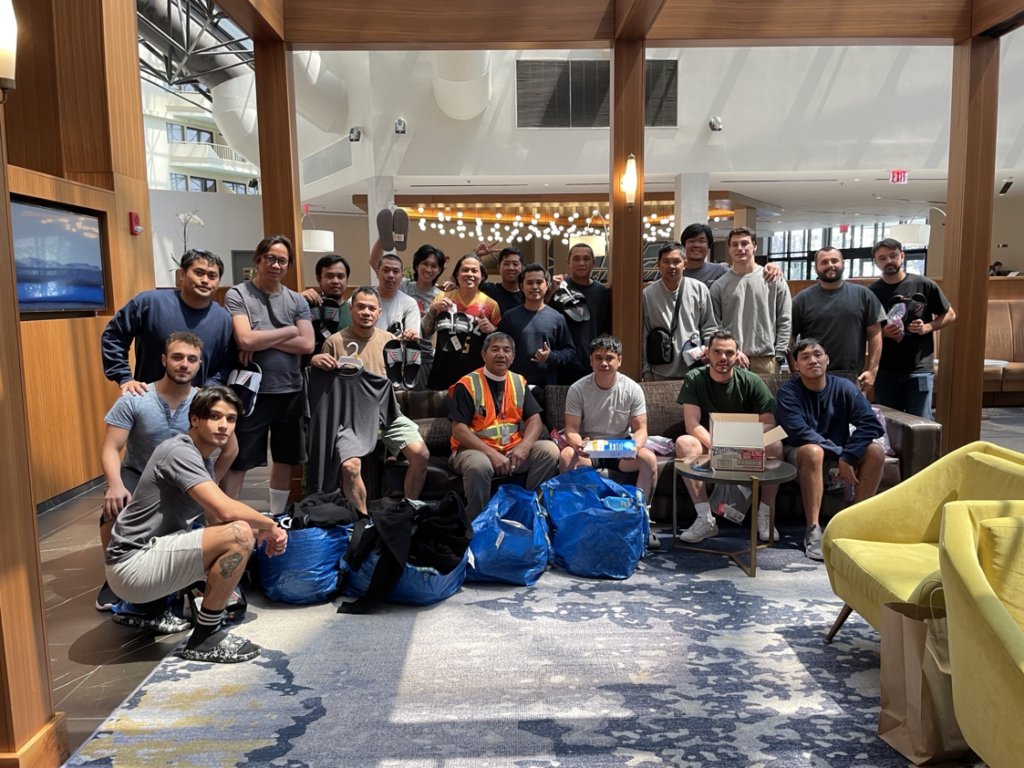What the Living Owe the Dead: Newark Port Fire Accountability

News stories like the horrific fire aboard the Grande Costa D’Avorio docked at Port Newark that killed two of Newark’s bravest have a predictable narrative arc. The media focuses intensely as the very real human drama unfolds, and then we look away, as our gaze shifts to the next sensational story.
We live in a world where we are increasingly reliant on a global supply chain, we expect to deliver goods the same or next day that may have originated anywhere in the world. How they arrive, who does it, what risks they take, or what corners are cut to make it all happen is usually of no consequence or concern to us.
That is until something like the Port Newark fire where the most selfless among us pay a price for our collective inattention to this global trade machine that generates billions and billions in profits by squeezing the margins.
In the short term, we do what we can for those we know that paid the ultimate price and then usually move on.
Newark firefighters Augusto Acabou, 45, and Wayne Brooks Jr., 49 who were killed fighting a fire aboard the auto-carrier Grande Costa D’Avorio on July 5, were posthumously promoted to the rank of Captain.
“There are only a few men and women that have to stand up when that bell rings—that have to stand watch while we are all asleep—that must respond when the call is made—that don’t have a stage of a mic-- they don’t have the luxury of turning back,” Mayor Ras Baraka told mourners at the funeral mass for Captain Acabou at Cathedral Basilica of the Sacred Heart “When their name is called they must be present and accounted for with honor and pride without trepidation walk into fires while we sit to side and watch.”
Meanwhile, in a more invisible universe, where the 28-member crew from the Grimaldi line’s Grande Costa D'Avario exists, the Seamen’s Church Institute, a non-profit founded in 1834 to aid stranded mariners, took to Facebook to raise money to help them.
“These seafarers had to abandon ship immediately, leaving their belongings and visa papers behind,” SCI’s post explains. “Since they have been unable to leave the hotel, SCI Chaplains continue to check in regularly and provide for their requests, including toiletries and much-needed clothing. These complete sets of clothing, shoes, backpacks, and duffle bags were purchased through SCI's "SOS Fund For Seafarers"—an emergency fund SCI established during COVID and sustained by the kindness and generosity of you, our donors. Thank you.”
Last year, SCI visited with close to 11,000 seafarers whose work brought them to the Port of New York & New Jersey. Over the years, SCI has had to come to the aid of international seafarers who have been entirely abandoned by their foreign owned shipping company.
During COVID, the international maritime workforce was thrust into a largely unreported humanitarian crisis.
“More than 300,000 seafarers are currently stranded on board ships, with some now have been working for more than 17 months at sea, without a break,” wrote the International Maritime Organization, during the pandemic. The IMO, the United Nations agency that oversees the maritime sector, added that “the crisis threatens the well-being of seafarers and puts navigational safety in peril.”
Long before the pandemic, the industry used automation and technology to justify significantly reducing crew size even as trade volume and profits continued to grow exponentially.
No doubt, the crew of the Grande Costa D’Avorio has an important story to tell investigators.
“A comprehensive formal investigation will be launched to determine the root causes and contributing factors leading to the shipboard fire,” according to a U.S. Coast Guard press release. “The investigation will be led by the Coast Guard in tandem with federal, state, and local entities including the National Transportation Safety Board, Bureau of Alcohol, Tobacco, Firearms and Explosives, New Jersey State Fire Marshal, New Jersey State Police, Newark Fire Arson Division, Essex County Prosecutor, and a host of safety agencies to ensure we gain a critical and necessary understanding of the incident.”
The Italian vessel is 12 stories high and was loaded with 1,200 cars as well as close to 160 containers bound for West Africa. The Port of Newark is operated by the Port Authority of New York and New Jersey and includes portions of Bayonne, Elizabeth, Newark, and Jersey City. The bistate agency relies entirely on the emergency services in the host communities which, in the case of Newark, has historically been under fiscal stress.
According to Newark Fire Chief Rufus Jackson, on the night of July 5, firefighters “found a working fire on the 10th floor—it was apparently five to seven vehicles fully involved [on fire]. The fire quickly extended to the 11th and 12th floor. The members made an attempt to extinguish the fire and because of the intense heat they got pushed back.”
Newark’s ill-fated response got off to a shaky start when NFD’s “Engine 16 quickly learned that their standard, 2.5-inch hose lines would not connect to equipment on the European-built ship,” reported the New York Times. “They were forced to use the vessel’s one-inch firefighting hoses, Newark’s Mayor Ras Baraka would later explain.”
The Newark fireboat wouldn’t start,” according to NorthJersey.com. And the FDNY, which has the region’s most robust marine based firefighting capability, did not get a request for mutual aid until 12:40 a.m. July 6, with Fire Commissioner Laura Kavanagh approving the mutual aid response around 1 a.m., three and a half hours after the initial response.
The fire continued to burn for days and was only declared out by the U.S. Coast Guard July 11th. During press briefings after the incident officials have said that typically precautions are taken when loading vehicles on auto carriers like the Grande Costa D’Avorio.
In June of 2020 an “electrical fault from an improperly disconnected battery in a used vehicle led” to a fire breaking out aboard the vehicle carrier Hoegh Xiamen that was docked in Jacksonville, Florida, according to the National Transportation Safety Board. The vessel was chartered by Grimaldi Deep Sea.
“Nine firefighters sustained injuries while responding,” the NTSB reported. “None of the vessel’s 21 crewmembers were injured. The fire took over a week to extinguish. The Hoegh Xiamen and its cargo of 2,240 used vehicles were declared a total loss valued at $40 million. In August 2020, after salvage operations were completed, the vessel was towed to Turkey to be recycled.”
In its final report, the NTSB determined that many of the vehicles has been loaded onto the vessel without their batteries being disconnected “which increased the risk of electrical arcing and component faults. During the loading operations, both the loading personnel and crew missed opportunities to address these hazards.”
The agency’s probe showed the detection of the fire was delayed because the vessel’s fire detection system had not yet been reactivated after the loading was completed. The local fie response was also delayed because the ship’s captain did not know how to contact first responders at the port. The NTSB ultimately determined the probable cause was the shipper’s “ineffective oversight” of the workers responsible for loading and securing the vessels.
“We found that used vehicles are often damaged and present an elevated risk of fire,” the NTSB concluded. “We believe that greater inspection, oversight, and enforcement are needed to reduce this risk.”
Evidently, there had been five similar incidents since 2015, including “a 2019 fire aboard Grimaldi’s Grande Europa,” according to the NTSB.
CBS News reported that the Grimaldi Group has had at least four other fires in recent years.
“Last February, a Grimaldi ferry caught fire near Greece. Authorities said at least eight people died,” CBS reported. “At the time, the Grimaldi Group said the fire started in an area of the ship where cars were parked. In November of 2019, an Italian fire brigade shared video of crews extinguishing a fire on a cargo ship operated by a Grimaldi company, Malta Motorways of the Sea. Firefighters said no one was hurt on the ship.”
A safety report from the Maltese government later concluded the fire was likely caused "most likely caused by fuel spilling accidentally onto a hot surface,” according to CBS.
Back in May of 2019, a Spanish rescue crew had to rescue “15 crew members after a fire started on a Grimaldi car carrier, and in March of 2019, Grimaldi's Grande America caught fire then sunk off the coast of France. All 27 people onboard were rescued,” reported CBS.
As for the July 5 blaze, Grimaldi maintains “the crew of the vessel immediately activated the on-board fire suppression procedures while the local firefighting services were alerted, and their prompt response played a crucial role in containing and bringing the fire under control."
Back in May of 2019, after the Grande Europa fire the Grimaldi Group issued a statement calling for more stringent regulations, according to the GCaptain, the international maritime news website.
“Following the umpteenth case of a fire that broke out on vehicles transported by cargo vessels, the Grimaldi Group launches an appeal to introduce more stringent controls and regulations on cargo sea transport, not only for rolling units but also for containers,” Grimaldi Group said.
The statement continued. “Notably, with reference to rolling freight, the Grimaldi Group requests that there be more controls on car batteries, which often cause short-circuits on board vessels, as well as in port terminals.”
Be great to know if the Port Authority of New York and New Jersey tracks any of this.
Editor's Note: Photo by Tim Wong, Director, Seamen's Church Institute.





